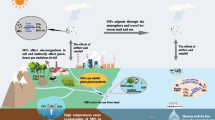Abstract
Leaves and fruits of Ricinus communis (castor oil plant) were studied as potential biomonitors of atmospheric pollution in urban areas. The concentrations of Al, As, Cd, Cr, Cu, Hg, Mn, Ni, Pb, and Zn were analyzed in samples collected in the city of Catania (Italy) and compared with a pristine area. This study showed that the fruits of R. communis act as better biomonitors of element concentrations in the atmosphere as compared to the leaves. In particular, this pattern was evident for Cu, Pb, and Zn, typical atmospheric pollutants. Fruits proved especially sensitive to Pb accumulation; thus, all products derived from them, such as castor oil and biofuels, should be obtained in places where the exposure to Pb is low to avoid potential contamination. The plant R. communis seems a promising species as a biomonitor of atmospheric pollution, and given its wide distribution, may be used for large-scale networks of biomonitoring.

Similar content being viewed by others
References
Adamo, P., Giordano, S., Naimo, D., & Bargagli, R. (2008). Geochemical properties of airborne particulate matter (PM10) collected by automatic device and biomonitors in a Mediterranean urban environment. Atmospheric Environment, 42, 346–357.
Al-Alawi, M. M., & Mandiwana, K. L. (2007). The use of Aleppo pine needles as bio-monitor of heavy metals in the atmosphere. Journal of Hazardous Materials, 148, 43–46.
Alfani, A., Maisto, G., Iovieno, P., Rutigliano, F. A., & Bartoli, G. (1996). Leaf contamination by atmospheric pollutants assessed by elemental analysis of leaf tissue, leaf surface deposit and soil. Journal of Plant Physiology, 148, 243–248.
Al-Khashman, O. A., & Shawabkeh, R. (2006). Metal distribution in soils around the cement factory in southern Jordan. Environmental Pollution, 140, 387–394.
Al-Khashman, O. A., Al-Muhtaseb, A. H., & Ibrahim, K. A. (2011). Dale palm (Phoenix dactylifera L.) leaves as biomonitors of atmospheric metal pollution in arid and semi-arid environments. Environmental Pollution, 159, 1635–1640.
Al-Khlaifat, A. L., & Al-Khashman, O. A. (2007). Atmospheric heavy metal pollution in Aqaba city, Jordan, using Phoenix dactylifera L. leaves. Atmospheric Environment, 41, 8891–8897.
Aničić, M., Spasić, T., Tomašević, M., Rajšić, S., & Tasić, M. (2011). Trace elements accumulation and temporal trends in leaves of urban deciduous trees (Aesculus hippocastanum and Tilia spp.). Ecological Indicators, 11, 824–830.
Bargagli, R. (1998). Trace elements in terrestrial plants. An ecophysiological approach to biomonitoring and biorecovery. Berlin: Springer.
Bargagli, R., Monaci, F., Borghini, F., Bravi, F., & Agnorelli, C. (2002). Mosses and lichens as biomonitors of trace metals. A comparison study on Hypnum cupressiforme and Parmelia caperata in a former mining district in Italy. Environmental Pollution, 116, 279–287.
Baycu, G., Tolunay, D., Ozden, H., & Sureyya, G. (2006). Ecophysiological and seasonal variations in Cd, Pb, Zn and Ni concentrations in the leaves of urban deciduous trees in Istanbul. Environmental Pollution, 143, 545–554.
Bonanno, G. (2012). Arundo donax as a potential biomonitor of trace element contamination in water and sediment. Ecotoxicology and Environmental Safety, 80, 20–27.
Çelik, A., Kartal, A. A., Akdoğan, A., & Kaska, Y. (2005). Determination of heavy metal pollution in Denizli (Turkey) by using Robinia pseudo-acacia L. Environment International, 31, 105–112.
Chaudhry, T. M., Hayes, W. J., Khan, A. G., & Khoo, C. S. (1998). Phytoremediation—focusing on accumulator plants that remediate metal-contaminated soils. Australasian Journal of Ecotoxicology, 4, 37–51.
Cheng, H., & Hu, Y. (2010). Lead (Pb) isotopic fingerprinting and its applications in lead pollution studies. A review. Environmental Pollution, 158, 1134–1146.
Clemens, S., Plamgren, M. G., & Kramer, U. (2002). A long way ahead: understanding and engineering plant metal accumulation. Trends in Plant Science, 7(7), 309–315.
De Bruin, M. (1990). Applying biomonitors and neutron activation analysis in studies of heavy metal air pollution. IAEA Bulletin, 4, 22–27.
De Temmerman, L., Bell, J. N. B., Garrec, J. P., Klumpp, A., Krause, G. H. M., & Tonneijck, A. E. G. (2004). Biomonitoring of air pollution with plants—considerations for the future. In A. Klumpp, W. Ansel, & G. Klumpp (Eds.), Urban air pollution, bioindication and environmental awareness (pp. 337–373). Göttingen: Cuvillier Verlag.
Directive 107/2004/EC of the European Parliament and of the Council relating to arsenic, cadmium, mercury, nickel and polycyclic aromatic hydrocarbons in ambient air. http://eur-lex.europa.eu/LexUriServ/LexUriServ.do?uri=OJ:L:2005:023:0003:0016:EN:PDF.
Divrikli, V., Soylak, M., Elic, L., & Dogan, M. (2003). Trace heavy metal levels in street dust samples from Yazgat city center, Turkey. Journal of Trace and Microprobe Techniques, 21, 351–361.
Figueiredo, A. M. G., Nogueira, C. A., Saiki, M., Milian, F. M., & Domingos, M. (2007). Assessment of atmospheric metallic pollution in the metropolitan region of São Paulo, Brazil, employing Tillandsia usneoides L. as biomonitor. Environmental Pollution, 145, 279–292.
Gratani, L., Crescente, M. F., & Varone, L. (2008). Long-term monitoring of metal pollution by urban trees. Atmospheric Environment, 42, 8273–8277.
Guzmán-Morales, J., Morton-Bermea, O., Hernández-Álvarez, E., Rodríguez-Salazar, M., García-Arreola, M. E., & Tapia-Cruz, V. (2011). Assessment of atmospheric metal pollution in the urban area of Mexico City, using Ficus benjamina as biomonitor. Bulletin of Environmetal Contamination & Toxicology, 86, 495–500.
Harrison, R. M., Tilling, R., Callen Romero, M. S., Harrad, S., & Jarvis, K. (2003). A study of trace metals and polycyclic aromatic hydrocarbons in the roadside environment. Atmospheric Environment, 37, 2391–2402.
Hovmand, M. F., Nielsen, S. P., & Johnsen, I. (2009). Root uptake of lead by Norway spruce grown on 210Pb spiked soils. Environmental Pollution, 157, 404–409.
Hsu, S.-C., Liu, S. C., Jeng, W.-L., Chou, C. C. K., Hsu, R.-T., Huang, Y.-T., et al. (2006). Lead isotope ratios in ambient aerosols from Taipei, Taiwan: identifying long-range transport of airborne Pb from the Yangtze Delta. Atmospheric Environment, 40, 5393–5404.
Kabata-Pendias, A., & Mukherjee, A. B. (2007). Trace elements from soil to human. Berlin: Springer.
Komárek, M., Ettler, V., Chrastný, V., & Mihaljević, M. (2008). Lead isotopes in environmental sciences: a review. Environment International, 34, 562–577.
Larcher, W. (2003). Physiological plant ecology (4th ed.). Berlin: Springer.
Lau, O. W., & Luk, S. F. (2001). Leaves of Bauhinia blakeana as indicators of atmospheric pollution in Hong Kong. Atmospheric Environment, 35, 3113–3120.
Markert, B. (1993). Plants as biomonitors. Indicators for heavy metals in the terrestrial environment. Weinheim: Wiley-VCH Verlag GmbH.
Markert, B. (1996). Instrumental element and multi-element analysis of plant samples. New York: WileySons Ltd.
Mingorance, M. D., & Oliva, S. R. (2006). Heavy metals content in N. oleander leaves as urban pollution assessment. Environmental Monitoring and Assessment, 119, 57–68.
Moraes, R. M., Klumpp, A., Furlan, C. M., Klumpp, G., Domingos, M., Rinaldi, M. C. S., et al. (2002). Tropical fruit trees as bioindicators of industrial air pollution in southeast Brazil. Environment International, 28, 367–374.
Moreno, E., Sagnotti, L., Dinarès-Turell, J., Winkler, A., & Cascella, A. (2003). Biomonitoring of traffic air pollution in Rome using magnetic properties of tree leaves. Atmospheric Environment, 37, 2967–2977.
Nowak, D. J. (2004). Assessing environmental functions and values of veteran tree. In G. Nicolotti & Gonthier (Eds.), Processing of the international congress on the protecion and exploitation of veteran trees (pp. 45–49). Torino: Region Piemonte and University of Torino.
Olowoyo, J. O., van Heerden, E., Fischer, J. L., & Baker, C. (2010). Trace metals in soil and leaves of Jacaranda mimosifolia in Tshwane area, South Africa. Atmospheric Environment, 44, 1826–1830.
Pyatt, F. B. (2001). Copper and lead bioaccumulation by Acacia retinoides and Eucalyptus torquata in sites contaminated as a consequence of extensive ancient mining activities in Cyprus. Ecotoxicology and Environmental Safety, 50, 60–64.
Rajkumar, M., & Freitas, H. (2008). Influence of metal resistant-plant growth-promoting bacteria on the growth of Ricinus communis in soil contaminated with heavy metals. Chemosphere, 71, 834–842.
Richardson, D. H. S., Shore, M., Hartree, R., & Richardson, R. M. (1995). The use of X-ray fluorescence spectrometry for the analysis of plants, especially lichens, employed in biological monitoring. The Science of the Total Environment, 176, 97–105.
Riveros-Rosas, H., Pfeifer, G. D., Lynam, D. R., Pedroza, J. L., Julian-Sanchez, A., Canales, O., et al. (1997). Personal exposure to elements in Mexico City air. Science of the Total Environment, 198, 79–96.
Rodriguez, J. H., Pignata, M. L., Fangmeier, A., & Klumpp, A. (2010). Accumulation of polycyclic aromatic hydrocarbons and trace elements in the bioindicator plants Tillandsia capillaris and Lolium multiflorum exposed at PM10 monitoring stations in Stuttgart (Germany). Chemosphere, 80, 208–215.
Roger, P., & Rix, M. (1999). Annuals and biennials. London: Macmillan.
Rossini Oliva, S., & Fernández Espinosa, A. J. (2007). Monitoring of heavy metals in topsoils, atmospheric particles and plant leaves to identify possible contamination sources. Microchemical Journal, 86, 131–139.
Rossini Oliva, S., & Rautio, P. (2005). Spatiotemporal patterns in foliar element concentrations in Ficus microcarpa L. f. growing in an urban area: implications for biomonitoring studies. Ecological Indicators, 5, 97–107.
Rühling, A., & Tyler, G. (1968). An ecological approach to the lead problem. Botaniska Notiser, 122, 248–342.
Shuman, L. M. (1994). Mineral nutrition. In R. E. Wilkinson (Ed.), Plant-environment interactions (pp. 149–182). New York: Marcel Dekker, Inc.
Smodiš, B., Pignata, M. L., Saiki, M., Cortés, E., Bangfa, N., Markert, B., et al. (2004). Validation and application of plants as biomonitors of trace element atmospheric pollution – a co-ordinated effort in 14 countries. Journal of Atmospheric Chemistry, 49, 3–13.
Sucharova, J., Suchara, I., Reimann, C., Boyd, R., Filzmoser, P., & Englmaier, P. (2011). Spatial distribution of lead and lead isotopes in soil B-horizon, forest-floor humus, grass (Avenella flexuosa) and spruce (Picea abies) needles across the Czech republic. Applied Geochemistry, 26, 1205–1214.
Tomašević, M., Rajšić, S., Đordević, D., Tasić, M., Krstić, J., & Novaković, V. (2004). Heavy metals accumulation in tree leaves from urban areas. Environmental Chemistry Letters, 2, 151–154.
Tomašević, M., Vukmirović, Z., Rajšić, S., Tasić, M., & Stevanović, B. (2008). Contribution to biomonitoring of some trace metals by deciduous tree leaves in urban areas. Environmental Monitoring and Assessment, 137, 393–401.
Tomašević, M., Antanasijević, D., Aničić, M., Deljanin, I., Perić-Grujić, A., & Ristić, M. (2013). Lead concentrations and isotope ratios in urban tree leaves. Ecological Indicators, 24, 504–509.
Urbat, M., Lehndorff, E., & Schwark, L. (2004). Biomonitoring of air quality in the Cologne Conurbation using pine needles as a passive sampler – part I: magnetic properties. Atmospheric Environment, 38, 3781–3792.
US Environmental Protection Agency (EPA) (1996). Publication 9345.0-12FSIEPA 540/F-95/038 PB95-963324, Intermittent Bulletin 3(2).
US Environmental Protection Agency (EPA) (2006). Lead Human Exposure and Health Risk Assessments and Ecological Risk Assessment for Selected Areas, Pilot Phase, External Review Draft Technical Report.
Van der Gon, H. D., & Appelman, W. (2009). Lead emissions from road transport in Europe. Science of the Total Environment, 407, 5367–5372.
Ward, N. I. (1990). Multielement contamination of British motorway environments. Science of the Total Environment, 93, 393–401.
World Health Organization (WHO) (2000). Air hygiene report no. 10. Biomonitoring of Air quality using plants, Geneva.
Zechmeister, H. G., Dullinger, S., Hohenwallner, D., Riss, A., Hanus-Illnar, A., & Scharf, S. (2006). Pilot study on road traffic emissions (PAHs, heavy metals) measured by using mosses in a tunnel experiment in Vienna, Austria. Environmental Science & Pollution Research, 13, 398–405.
Acknowledgments
The author wishes to thank all the people involved in the sampling, and that provided scientific support. This study was partially financed by the Italian Ministry of University and Scientific Research (PRA no. 20104001098/2010).
Author information
Authors and Affiliations
Corresponding author
Rights and permissions
About this article
Cite this article
Bonanno, G. Ricinus communis as an Element Biomonitor of Atmospheric Pollution in Urban Areas. Water Air Soil Pollut 225, 1852 (2014). https://doi.org/10.1007/s11270-013-1852-2
Received:
Accepted:
Published:
DOI: https://doi.org/10.1007/s11270-013-1852-2




